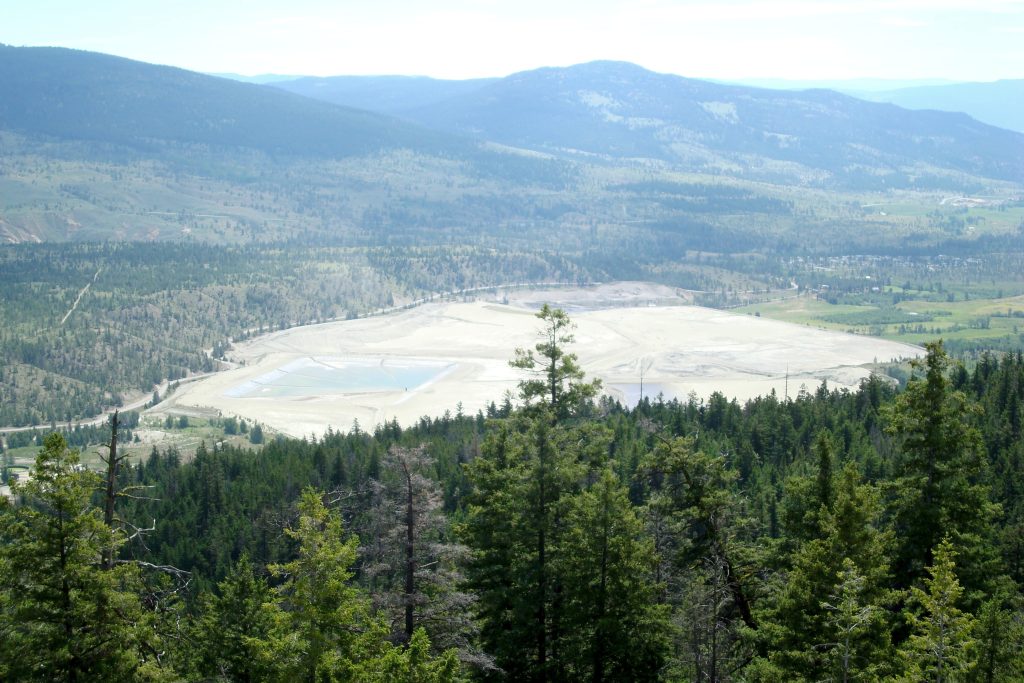A new look at the word “tailings”

The tailings pond of Nicola Mining near Merritt, southwestern British Columbia. Photo by Ellsworth Dickson
Natural and anthropogenic tailings waste threaten rural, urban, biodiversity areas around the world; however, innovative technology can mitigate this.
By Bruce Downing, M.Sc, P.Geo.
Tailings are residual material(s) or waste generated or created from ores, gravel, tar sands, grain, lumber, manufacturing, volcanoes, to name a few. Tailings can occur as mine, anthropogenic and geologically derived entities.
Mine Tailings
Mine tailings are generated from the processing of ores and are generally stored under water to prevent the process of metal leaching and/or acid rock drainage. Large land-based tailings storage facilities (TSF) are created to store the mine effluent. In some situations, tailings have been stored in natural underwater reservoirs such as in lakes or in the ocean. Ocean tailings storage facilities would eliminate some of the land-based mine TSF if the mine is close to the ocean and environmental parameters can be met.
Some companies are now proposing to mine mineral rich sediments on the ocean floor, create tailings from it and then possibly return the tailings back to the original place, the ocean floor.
Some companies are investigating the re-processing of historic mine tailings as they may contain some economical precious and base metals such as gold, silver, copper, zinc, (to name a few). With today’s better analytical techniques, rare earths may also be discovered. There are also some new innovative methods of re-processing and/or re-purposing (i.e. carbon sequestration) mine tailings.
Anthropogenic Tailings
Anthropogenic tailings (plastics, gypsum board, garbage, diapers, food, household products etc) can be considered as residual waste which are discarded into landfill sites (LFS). The present “throw away culture” leads to the tailings of modern life (i.e. plastics) found in some water environments. Some environmental tailings can be recycled or burned to produce heat and / or electricity. It is speculated that LFS can be re-mined for materials that can be re-cycled and / or re-used.
Geologically Derived Tailings
Geologically derived tailings can be construed as residual material resulting from volcanic activity such as volcanic ash which can permeate the atmosphere, waters and land for up to several hundreds of years. Some of these deposits are beneficial to mankind (i.e., bentonite, zeolites).
Discussion
Mine and environmental tailings should be considered in terms of waste management. Mine tailings are collected, stored and monitored in designated site-specific areas. Environmental tailings can be dispersed in regulated and unregulated landfill sites with a major human intervention of disposing environmental tailings anywhere on land, rivers, lakes and ocean. Many LFS are not monitored and are subject to seepages of potential toxic residues. Waters have become a labyrinth of visible floating dispersion sites.
Tailings storage facilities have the propensity to fail with human consequences and / or release elements to the environment that may have a harmful impact. Landfill sites have the propensity to catch fire and release toxic fumes as well as release elements via ground / surface water to the environment. Methane gas is also produced from some landfill sites.
I would surmise that more micro-nano plastic and disposable (plastics) material is of greater amount and dispersed more widely than mine tailings. You can re-mine and to some extent re-cycle mine tailings as mine tailings are relegated to confined areas whereas plastics and other human-derived wastes are dispersed over ocean, lakes, rivers and landfill sites.
Both TSF and LFS require environmental permitting, engineering and monitoring. Both can be re-claimed back into a natural environment over time (hundreds of years). Both have the propensity to contain material that can be re-processed and/or re-cycled. Historic TSF and LFS should be reviewed. As this planet is becoming littered with “tailings” that should be addressed for removal, re-cycling, re-processing, re-using and re-disposal, there are attempts to rectify this problem through innovative and alternative approaches.
